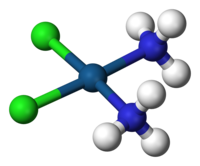
Photo from wikipedia
Guiding nitrenes away from a migration Nitrogen conventionally shares its electrons in three bonds with one or more partners. A singly bonded nitrogen, or nitrene, is exceptionally reactive and can… Click to show full abstract
Guiding nitrenes away from a migration Nitrogen conventionally shares its electrons in three bonds with one or more partners. A singly bonded nitrogen, or nitrene, is exceptionally reactive and can insert itself into normally inert C–H bonds. If the nitrene forms next to a carbonyl center, though, it tends to react with the C–C bond on the other side instead. Hong et al. used theory to guide the design of an iridium catalyst that inhibits this rearrangement, steering the nitrene toward C–H insertion to form a variety of useful lactam rings. Science, this issue p. 1016 Theory guides design of a catalyst to cyclize amides via a nitrene intermediate otherwise prone to a competing rearrangement. Intramolecular insertion of metal nitrenes into carbon-hydrogen bonds to form γ-lactam rings has traditionally been hindered by competing isocyanate formation. We report the application of theory and mechanism studies to optimize a class of pentamethylcyclopentadienyl iridium(III) catalysts for suppression of this competing pathway. Modulation of the stereoelectronic properties of the auxiliary bidentate ligands to be more electron-donating was suggested by density functional theory calculations to lower the C–H insertion barrier favoring the desired reaction. These catalysts transform a wide range of 1,4,2-dioxazol-5-ones, carbonylnitrene precursors easily accessible from carboxylic acids, into the corresponding γ-lactams via sp3 and sp2 C–H amidation with exceptional selectivity. The power of this method was further demonstrated by the successful late-stage functionalization of amino acid derivatives and other bioactive molecules.
Journal Title: Science
Year Published: 2018
Link to full text (if available)
Share on Social Media: Sign Up to like & get
recommendations!